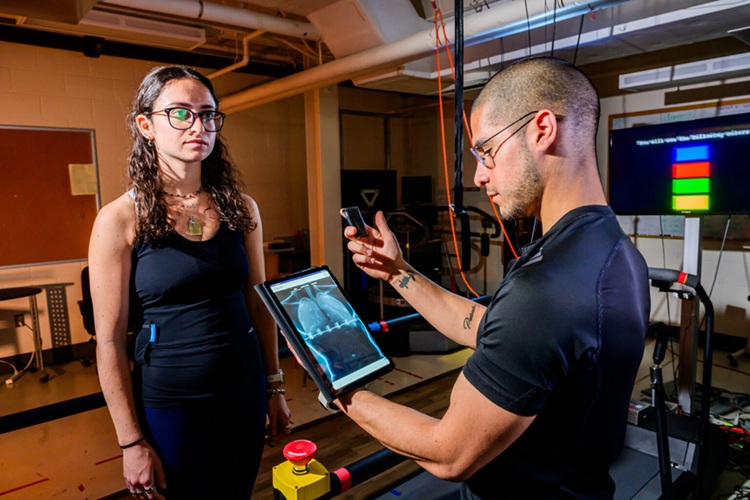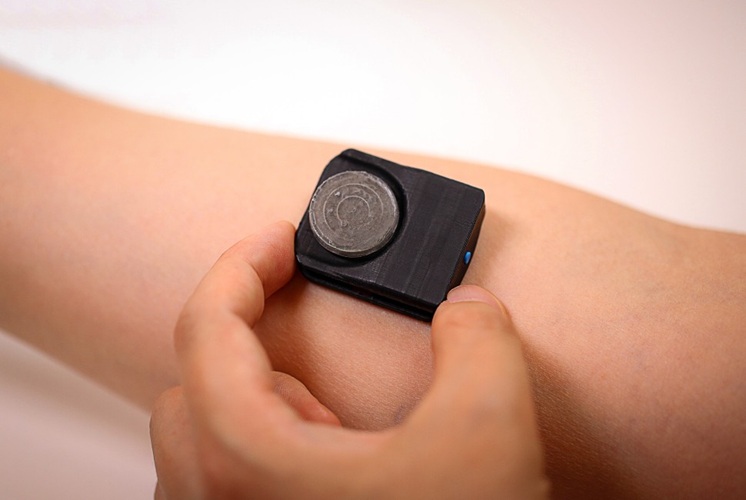Innovative Magnetic Platform Expedites Gallbladder Removal
|
By HospiMedica International staff writers Posted on 31 Aug 2016 |

Image: The Levita magnetic surgical system (Photo courtesy of Levita Magnetics).
A novel magnetic surgery system grasps and retracts tissue and organs in laparoscopic cholecystectomy procedures, facilitating access and visualization of the surgical site.
The Levita Magnetic Surgical System is comprised of a magnetic grasper device with a detachable tip and a magnetic controller. The grasper is inserted into the abdominal cavity via a small incision; once the magnetic tip reaches the gallbladder, the surgeon deploys it, attaching it to the body and the fundus of the gallbladder, and removes the grasper. The surgeon then uses the magnetic controller to maneuver and lift the gallbladder via a magnetic field, without damaging the abdominal wall. Once near the opening, the grasper is re-inserted to retrieve the magnetic tip and attached gallbladder.
The system reduces complications during surgery--such as organ injuries, bleeding, or pain--and also provides a better procedure for the surgeon, with less instrument crowding and less scarring for the patient. The Levita Magnetic Surgical System is a product of Levita Magnetics (San Mateo, CA, USA), and has been approved by the U.S. Food and Drug Administration (FDA) for laparoscopic cholecystectomy in patients within a body mass index (BMI) range of 20- 34 kg/m2.
“We are proud to be the pioneers of magnetic surgery. Having been a minimally invasive surgeon for over 10 years, I understand the complexity my peers face when trying to gain proper access to organs,” said surgeon Alberto Rodriguez-Navarro, MD, founder and CEO of Levita Magnetics. “Our goal at Levita is to equip surgeons with the technology they need to make surgery easier and less invasive, while enabling improved patient outcomes.”
In traditional laparoscopic cholecystectomy, four incisions are made in the abdomen: one on the rim of the navel, one beneath the navel, and two beneath the navel and to the right. A laparoscope and surgical instruments are passed into the interior of the abdomen to aid the surgeon in removal of the gallbladder. The new magnetic system reduces the number of incisions needed.
Related Links:
Levita Magnetics
The Levita Magnetic Surgical System is comprised of a magnetic grasper device with a detachable tip and a magnetic controller. The grasper is inserted into the abdominal cavity via a small incision; once the magnetic tip reaches the gallbladder, the surgeon deploys it, attaching it to the body and the fundus of the gallbladder, and removes the grasper. The surgeon then uses the magnetic controller to maneuver and lift the gallbladder via a magnetic field, without damaging the abdominal wall. Once near the opening, the grasper is re-inserted to retrieve the magnetic tip and attached gallbladder.
The system reduces complications during surgery--such as organ injuries, bleeding, or pain--and also provides a better procedure for the surgeon, with less instrument crowding and less scarring for the patient. The Levita Magnetic Surgical System is a product of Levita Magnetics (San Mateo, CA, USA), and has been approved by the U.S. Food and Drug Administration (FDA) for laparoscopic cholecystectomy in patients within a body mass index (BMI) range of 20- 34 kg/m2.
“We are proud to be the pioneers of magnetic surgery. Having been a minimally invasive surgeon for over 10 years, I understand the complexity my peers face when trying to gain proper access to organs,” said surgeon Alberto Rodriguez-Navarro, MD, founder and CEO of Levita Magnetics. “Our goal at Levita is to equip surgeons with the technology they need to make surgery easier and less invasive, while enabling improved patient outcomes.”
In traditional laparoscopic cholecystectomy, four incisions are made in the abdomen: one on the rim of the navel, one beneath the navel, and two beneath the navel and to the right. A laparoscope and surgical instruments are passed into the interior of the abdomen to aid the surgeon in removal of the gallbladder. The new magnetic system reduces the number of incisions needed.
Related Links:
Levita Magnetics
Latest Surgical Techniques News
- Intravascular Imaging for Guiding Stent Implantation Ensures Safer Stenting Procedures
- World's First AI Surgical Guidance Platform Allows Surgeons to Measure Success in Real-Time
- AI-Generated Synthetic Scarred Hearts Aid Atrial Fibrillation Treatment
- New Class of Bioadhesives to Connect Human Tissues to Long-Term Medical Implants
- New Transcatheter Valve Found Safe and Effective for Treating Aortic Regurgitation
- Minimally Invasive Valve Repair Reduces Hospitalizations in Severe Tricuspid Regurgitation Patients
- Tiny Robotic Tools Powered by Magnetic Fields to Enable Minimally Invasive Brain Surgery
- Magnetic Tweezers Make Robotic Surgery Safer and More Precise
- AI-Powered Surgical Planning Tool Improves Pre-Op Planning
- Novel Sensing System Restores Missing Sense of Touch in Minimally Invasive Surgery
- Headset-Based AR Navigation System Improves EVD Placement
- Higher Electrode Density Improves Epilepsy Surgery by Pinpointing Where Seizures Begin
- Open-Source Tool Optimizes Placement of Visual Brain Implants
- Easy-To-Apply Gel Could Prevent Formation of Post-Surgical Abdominal Adhesions
- Groundbreaking Leadless Pacemaker to Prevent Invasive Surgeries for Children
- Spectroscopy Technique Improves Surgery for Pediatric Epilepsy Patients
Channels
Critical Care
view channel
Novel Intrabronchial Method Delivers Cell Therapies in Critically Ill Patients on External Lung Support
Until now, administering cell therapies to patients on extracorporeal membrane oxygenation (ECMO)—a life-support system typically used for severe lung failure—has been nearly impossible.... Read more
Generative AI Technology Detects Heart Disease Earlier Than Conventional Methods
Detecting heart dysfunction early using cost-effective and widely accessible tools like electrocardiograms (ECGs) and efficiently directing the right patients for more expensive imaging tests remains a... Read more
Wearable Technology Predicts Cardiovascular Risk by Continuously Monitoring Heart Rate Recovery
The heart's response to physical activity is a vital early indicator of changes in health, particularly in cardiovascular function and mortality. Extensive research has demonstrated a connection between... Read more
Wearable Health Monitoring Device Measures Gases Emitted from and Absorbed by Skin
The skin plays a vital role in protecting our body from external elements. A key component of this protective function is the skin barrier, which consists of tightly woven proteins and fats that help retain... Read morePatient Care
view channel
Portable Biosensor Platform to Reduce Hospital-Acquired Infections
Approximately 4 million patients in the European Union acquire healthcare-associated infections (HAIs) or nosocomial infections each year, with around 37,000 deaths directly resulting from these infections,... Read moreFirst-Of-Its-Kind Portable Germicidal Light Technology Disinfects High-Touch Clinical Surfaces in Seconds
Reducing healthcare-acquired infections (HAIs) remains a pressing issue within global healthcare systems. In the United States alone, 1.7 million patients contract HAIs annually, leading to approximately... Read more
Surgical Capacity Optimization Solution Helps Hospitals Boost OR Utilization
An innovative solution has the capability to transform surgical capacity utilization by targeting the root cause of surgical block time inefficiencies. Fujitsu Limited’s (Tokyo, Japan) Surgical Capacity... Read more
Game-Changing Innovation in Surgical Instrument Sterilization Significantly Improves OR Throughput
A groundbreaking innovation enables hospitals to significantly improve instrument processing time and throughput in operating rooms (ORs) and sterile processing departments. Turbett Surgical, Inc.... Read moreHealth IT
view channel
Printable Molecule-Selective Nanoparticles Enable Mass Production of Wearable Biosensors
The future of medicine is likely to focus on the personalization of healthcare—understanding exactly what an individual requires and delivering the appropriate combination of nutrients, metabolites, and... Read more
Smartwatches Could Detect Congestive Heart Failure
Diagnosing congestive heart failure (CHF) typically requires expensive and time-consuming imaging techniques like echocardiography, also known as cardiac ultrasound. Previously, detecting CHF by analyzing... Read moreBusiness
view channel
Expanded Collaboration to Transform OR Technology Through AI and Automation
The expansion of an existing collaboration between three leading companies aims to develop artificial intelligence (AI)-driven solutions for smart operating rooms with sophisticated monitoring and automation.... Read more















